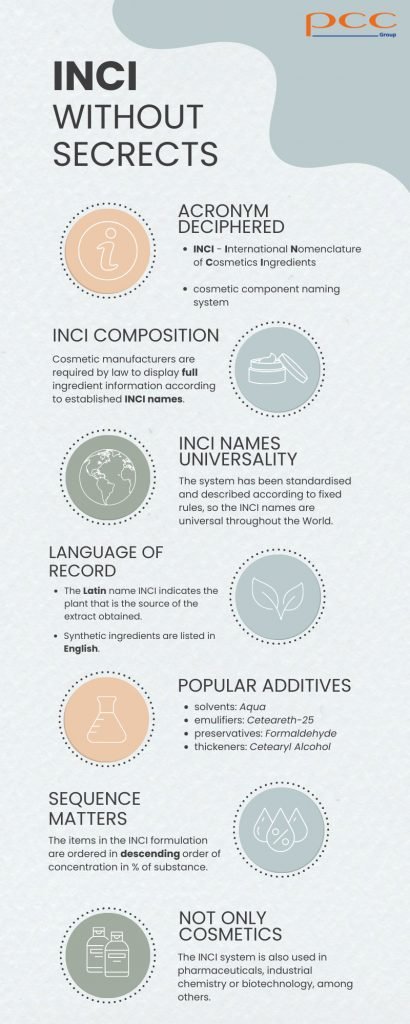International consumer protection law requires that the composition of cosmetics is clearly specified by the manufacturer. INCI names are intended to ensure the transparency and universality of these mandatory descriptions. How should they be interpreted?
INCI originates from English and it stands for International Nomenclature of Cosmetics Ingredients. This system was developed as early as the beginning of the 1970s and is now obligatory throughout the European Union, as well as in other developed countries, such as the USA and Canada. The idea is simple – to provide the consumer with reliable information for an optimal purchase.
INCI names’ goal is to overcome the language barrier that, today, often separates the cosmetics’ manufacturer and consumer. In a global market, information about a product’s composition must be understandable, in different countries. The INCI system is also supposed to eliminate any inconsistencies between the common names of individual substances and their scientific nomenclature.
The basic principles of determining the ingredients of INCI cosmetics are very simple. Firstly, the manufacturer is obliged to list, on the packaging, all compounds used in the manufacturing of a given product. This includes waxes, oils, pigments, preservatives and fragrances. Chemical substances should be listed under their official English names, while plant extracts have to be listed under their Latin names.
Secondly, the order of listing of the individual ingredients must reflect their quantitative contribution to the product. Base ingredients are listed first (e.g. alcohols), followed by active ingredients (e.g. retinol), after which you write down auxiliary ingredients (e.g. colourants or emulsifiers). Importantly, INCI ingredients with a concentration of less than 1% in the product may be listed in any order, at the end of the list.
One of the most commonly used ingredients in cosmetics is water. It may be purified, distilled, deionised or demineralised. According to INCI rules, it should always be referred to as Aqua. In this way, consumers receive abbreviated, essential information in a form that is easy to understand.
Some chemical substances can, of course, be difficult to interpret for the layman. However, it is useful to know the basic ingredients of a cosmetic product, under the various INCI names, e.g:
Contrary to popular belief, the official-sounding names on the labels of cosmetics do not necessarily hide ‘chemicals’ in the negative sense of the word. The length of the INCI composition is also not a definitive criterion for assessing the effectiveness or safety of a given preparation!
Even the names of plant ingredients, which are particularly sought after in cosmetics today, may be more incomprehensible. The majority of manufacturers inform about beneficial botanical extracts as part of advertising or designs on the packaging. However, it is worth being able to recognise key INCI names such as:
The unification of the naming of cosmetic ingredients is not just a legal formality. For every consumer, the INCI composition is a basic source of information about the content of individual products. Thanks to this, the consumer can make a rational, economic and healthy choice.
What does it look like in practice? By comparing INCI names on packaging, you can verify whether the differences between the prices of two creams are actually justified with better composition. At the same time, you have the chance to avoid ingredients to which you are allergic or which do not suit you for ideological reasons.
Online databases offer comprehensive INCI catalogues, where you can check the advantages and disadvantages of each ingredient. In this way, over time you can learn to draw conclusions about the optimal cosmetics for you. Today, knowledge is the consumer’s most important weapon!
Just because you understand the INCI names, it does not mean that you have full knowledge of the product or its potential effects. Cosmetics that are similar in composition may, for example, have different functions, because one has more active compounds than another. It is therefore difficult to make a fair comparison without knowing the concentrations.
Also, pay attention to the origin of the ingredients. In this case, you cannot discern much just from the INCI list. If you are concerned about safety and ecology, look for additional information on the cosmetics label, e.g. in the form of international pictograms.
Please also note that the complete list of INCI names contains up to 1,600 names! You do not need to know or understand all of them. However, basic knowledge will certainly help you to make more informed and responsible purchasing decisions.


Check out our infographic about INCI!
Download the infographic in PDF format
